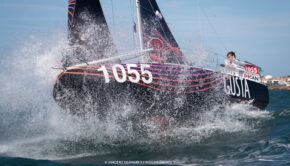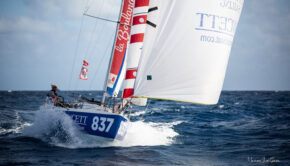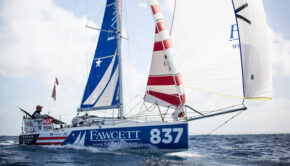Mini Transat: Rally and Regroup
Published on November 1st, 2013
(November 1, 2013) – They are almost all there. With the exception of two or three competitors still at sea, the entire fleet of the Mini Transat is now warm and dry, either in the marina at Sada, or in the port of Gijon. The start will be from Sada as soon as the 76 boats still racing have been able to rally at the Galician port. A weather window is opening from Tuesday 5.
It is unclear if that will be enough time for American Jeff MacFarlane, one of the race favorites in the proto division. His mast broke on October 31 in moderate conditions after a tack. He started to jury rig and notified Race HQ he was going to continue – BUT they insisted that he abandon the boat and get on board the companion (safety) boat. He is now stuck there at sea – with limited internet and no phone – until the last boat finishes.
“I am not giving up,” stated MacFarlane. “I am sitting on a navy ship trying to arrange for a new mast, new sails, and for the boat to be brought back to shore with very limited internet access and no phone. We will be back to land Saturday once all Minis (except mine) are in port, safe and sound. While the chances are slim, I am hoping to rejoin the race.”
Taking into consideration the legitimate disappointment of the competitors who were able to complete the course for this first stage between Douarnenez and Sada, the differing skill levels of the sailors in a class which is by by definition diverse, and the constraints of the particularly hostile weather, the decision to cancel the first stage was not easy. Among all these parameters, it is obvious that the safety of sailors is paramount. It was also necessary to find shelter for a fleet of over 70 boats. The links between Douarnenez and Club Naval de Gijon, and the responsiveness of the harbour master of the Asturian marina, actively supported by the City of Gijon, have been crucial to the success of the operation.
Gijon to Sada – the Cantabrian ride
Tonight, almost the entire fleet will be safe in Gijon, with the exception of five prototypes that are at the marina in Sada. Logic dictates that it is the fleet held in Gijon that must regroup in Sada in order to start. This is partly because the estuary at Sada is in an ideal strategic position from which to pass Cape Finisterre, but also because it would be a kind of double jeopardy to ask the five solo sailors who had managed to complete the course to backtrack east to Gijon. A weather window seems to be emerging during the day on Tuesday that would allow competitors to come to the starting line in convoy. It will then take four to six days of racing to reach Lanzarote where the technical stopover whould be shortened drastically to try to reclaim at least part of the time lost on the road to the West Indies.
What they say :
Nicolas Boidevezi (Nature Addicts)
“The decision to abandon the stage did not really follow the formal approach. However the goal was to get all boats to safety before the storm hits the fleet today. This is what the Race Director was doing in passing the message of the break via the support boats. For sure this is not a decision that’s good to hear, but at the same time, the difficulty for the organisation is to take into account all 84 competitors, from first to last.”
Bertrand Delesne (TeamWork)
“I found the start of the race was hard. In the bay, it was gusting up to 25 knots. We hadn’t sailed for a month so it was a little tough. The passage through the Raz de Sein went well but there were big puffs coming down. I thought it was pretty boat-breaking. I didn’t want to push the boat too hard at that moment. I had a feeling that we could be in the bullshit.”
Robin Marais (Marcel for Ever)
“The start was very stressful because of the weather conditions. I’d not managed to pick up the weather with the SSB. But after discussion on VHF with other sailors who had questions about the weather, I saw a lot began to turn around and I decided to accompany them. I did not want to be on my own out there. I didn’t have much more than thirty knots of wind, but the sea was really big. ”
Arnaud Daval (Techneau)
“It was not easy conditions. We knew at the outset that the conditions would be difficult, which the technical problems of some of the others reflected. I didn’t want to push the boat too hard, I tried to maintain my equipment. For me the Transat is not finished at Cape Finisterre so if I want to make it to the end, we have to look after our mounts. I paid attention to this and I did not break anything. When the cancellation of the race was announced, I pulled on the tiller and went back towards Gijon.”
Race Schedule
Leg 1 – Douarnenez (France) to Puerto Calero (Lanzarote, Canary Islands): 1257 miles, 10-13 days.
Start from Douarnenez originally planned for October 13, 2013. Departure postponed to October 29 due to severe weather conditions on the race course. During Leg 1, the fleet was diverted to Sada, near La Coruna at the north west tip of Spain, to wait out strong weather. After the fleet was nearly two-thirds across the Bay of Biscay, this shortened leg was cancelled due to weather to allow competitors to reach port safely. The race from Sada to Lanzarote will restart when safe weather allows.
Leg 2 – Puerto Calero (Lanzarote, Canary Islands) to Pointe-à-Pitre (Guadeloupe): 2764 miles, 14-21 days.
Start from Canary Islands originally planned for November 9, 2013. Start now unknown due to Leg 1 delays.
Event website: http://www.minitransat.fr/?lang=en









 We’ll keep your information safe.
We’ll keep your information safe.